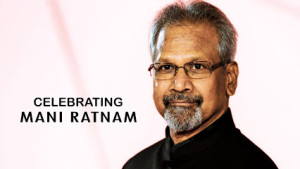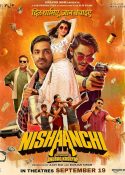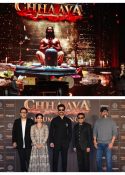 Mani Ratnam (b. 1955, Chennai) is that rarest of film directors nowadays: an artist capable of making exquisitely crafted, hugely entertaining, yet intelligent and provocative films on a range of social and political issues. Museum of the Moving Image is proud to present a special tribute to Ratnam featuring the director in person with a trilogy of films that follow lovers against a backdrop of Indian politics: Roja(1992), Bombay (1995), and Dil Se (1998)—the last featuring one of the most famous scenes in all of Indian cinema, the “Chaiyya Chaiyya” musical number on top of a moving train. The series, Politics as Spectacle: The Films of Mani Ratnam, runs from July 31 through August 2, 2015. Ratnam will participate in conversations after each film, moderated by Richard Peña.
Mani Ratnam (b. 1955, Chennai) is that rarest of film directors nowadays: an artist capable of making exquisitely crafted, hugely entertaining, yet intelligent and provocative films on a range of social and political issues. Museum of the Moving Image is proud to present a special tribute to Ratnam featuring the director in person with a trilogy of films that follow lovers against a backdrop of Indian politics: Roja(1992), Bombay (1995), and Dil Se (1998)—the last featuring one of the most famous scenes in all of Indian cinema, the “Chaiyya Chaiyya” musical number on top of a moving train. The series, Politics as Spectacle: The Films of Mani Ratnam, runs from July 31 through August 2, 2015. Ratnam will participate in conversations after each film, moderated by Richard Peña.
“Mani Ratnam is a treasure, and we are pleased to host him in New York with three of his most significant and beloved films,” said Christina Marouda, the Museum’s Deputy Director for Development and Founder of the Indian Film Festival in Los Angeles, who organized this program. “This weekend tribute offers audiences, both devoted fans and new viewers, a rare opportunity to see his gorgeous films on the big screen, presented in 35mm.”
Richard Peña, Director Emeritus, New York Film Festival and Professor of Film Studies at Columbia University, added: “The false dichotomies that are used to categorize films—art vs. commercial cinema, entertainment vs. political filmmaking—disappear when one sees how easily Mani Ratnam is able to combine aspects of all of them into his work. A New York tribute to this important filmmaker is long overdue.”
The three films in this series are also notable for featuring the music of A.R. Rahman, who made his debut as a film composer on Roja. Having heard Rahman’s work composing ad jingles, Ratnam persuaded him to work on this film, and thereby started Rahman’s astonishing career as a major movie composer. Time magazine listed Roja as among the “Ten Best Soundtracks” of all time (a list compiled by Richard Schickel and Richard Corliss in 2005).
Widely credited as the director who revolutionized Tamil-language cinema—an industry just as prolific as its far better known “Bollywood” Hindi-language cousin—Mani Ratnam was born into a film family, his father a noted film distributor. Ratnam was sent off to study business in Mumbai, and thereafter landed a job with a management firm, but there was celluloid in his blood, and he soon drifted into film production, writing and directing his first film, Pallavi Anu Pallavi, in 1983. Although it fared poorly at the box office, his talent was definitely noted, and soon he had invitations from a number of producers to develop projects. His 1986 Mouna Ragam was seen as a decisive new direction in Tamil cinema, with its closely observed tale of difficult first months of a newly-wed couple. That was followed by Nayakan (1987), Ratnam’s gloss on The Godfather, which became an enormous hit all over India and received three national film awards. Without any doubt, after Nayakan, Mani Ratnam was widely considered one of India’s leading directors, a position he managed to maintain for almost 30 years.
Special thanks to Richard Peña and Uma da Cunha. Politics as Spectacle: The Films of Mani Ratnam is part of the Museum’s community engagement initiative supported by the Ford Foundation. Additional support for this program is provided by the Consulate General of India in New York, The Pierre Hotel, and Con Edison.
SCHEDULE FOR ‘POLITICS AS SPECTACLE: THE FILMS OF MANI RATNAM,’
JULY 31–AUGUST 2, 2015
All screenings take place in the Sumner M. Redstone Theater at Museum of the Moving Image, 36-01 35 Avenue in Astoria, New York.
Tickets for each screening are $15 ($9 for Museum members at the Film Lover, Dual, and Family levels / free for Silver Screen members and above). Advance tickets are available online at http://www.movingimage.us/ManiRatnam
Roja
Followed by a discussion with Mani Ratnam and Richard Peña
FRIDAY, JULY 31, 7:00 P.M.
Dir. Mani Ratnam. 1992, 175mins. 35mm. With Arvind Swamy, Madhoo. A marriage is being arranged for computer engineer Rishi and a beautiful young woman, but when he meets her she begs him to marry her sister instead. So Roja becomes Rishi’s wife, a development about which she is not happy. But when she discovers that Rishi is truly a good man, she decides to devote herself to him anyway. During a trip to Kashmir, Rishi is kidnapped by separatists, who hope to use him for a prisoner exchange; all alone, Roja moves heaven and earth to set him free, fighting against the indifference of the police, the Army, and government officials.

Bombay
Followed by a discussion with Mani Ratnam and Richard Peña
SATURDAY, AUGUST 1, 4:00 P.M.
Dir. Mani Ratnam. 1995, 141 mins. 35mm. With Arvind Swamy, Manisha Koirala. Returning to his Southern Indian town, Shekhar falls in love with Shaila, daughter of a local brick maker. The only problem is that he is Hindu, she is Muslim, and their families are dead set against the match. The couple elopes to Bombay (Mumbai), where they hope, in the cosmopolitan capital, they can lead their own lives. Too late: Against the background of the riots following the destruction of the Babri Masjid Mosque in Ayodhya, interfaith strife soon engulfs the city. A passionate, deeply felt call for tolerance,Bombay puts a human face on an ongoing tragedy of devastating proportions.

Dil Se
Followed by a discussion with Mani Ratman and Richard Peña and a reception
SUNDAY, AUGUST 2, 4:00 P.M.
Dir. Mani Ratnam. 1998, 164 mins. 35mm. With Shahrukh Khan, Manisha Koirala. Screened to great acclaim at Berlin’s Forum for Young Film, Dil Sebegins as All-India Radio reporter Amar (the indomitable Shahrukh Khan) is stuck in a train station, waiting for the express that will take him to his next assignment. He spies a beautiful young woman and is instantly smitten, but she disappears on him; she will return, unexpectedly, to become a factor in his life, again and again—even though her ultimate aim is not clear. Romance, separatist politics, terrorism, and some eye-popping dance numbers perfectly blend in this visual tour-de-force that remains one of Ratnam’s most beloved films.










